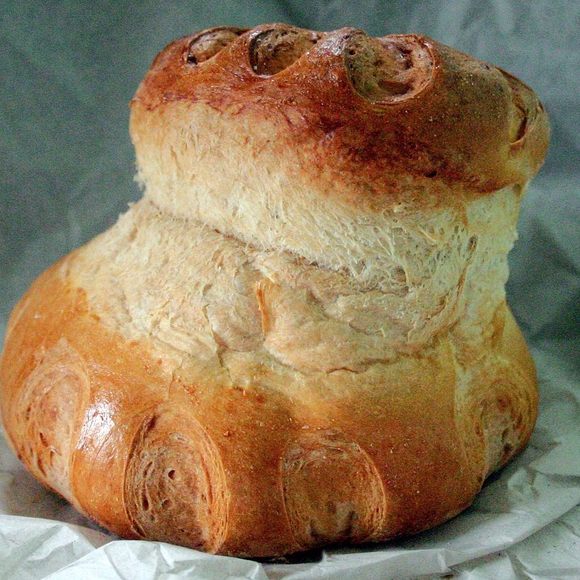The cottage loaf is a beloved feature in some British bakeries. Its instantly recognizable shape, formed by placing one smaller, round loaf on top of a larger one, gives it both a unique look and a textural contrast of soft and crusty. The reason for its strange, stacked formation? It was likely a space-saving tactic in tiny bread ovens.
Cottage loaf is notoriously difficult and time-consuming to bake. The trickiness lies in linking and balancing the disparately sized loaves. If the top loaf is too heavy, it will sink into the bottom, leaving a doughy mess. To add another layer of complexity, many versions were once decorated with numerous slashes around the edges, creating a beautiful pattern after baking.
One person who wasn’t fazed by the process was the British writer Virginia Woolf, who claimed that her only true passion was cooking. And her specialty was the cottage loaf. In Recollections of Virginia Woolf, her own cook, Louie Mayer, describes the writer’s cottage loaf–making abilities: “I would say that Mrs Woolf was not a practical person … but this was a job needing practical skill which she was able to do well every time.”
Another British literary luminary who loved the cottage loaf was George Orwell. In his essay In Defence of English Cooking, he sings the praises for various English foodstuffs, from kippers to crumpets to Stilton cheese. He also mentions local bread, highlighting one in particular: “If there is anything quite as good as the soft part of the crust from an English cottage loaf (how soon shall we be seeing cottage loaves again?) I do not know of it.”
Where to Try It
-
Cottage Loaf Bakery
760-762 Wimborne Road, Bournemouth, BH9 2DZ, EnglandThis bakery makes the signature loaf, plus tiny cottage rolls for those with smaller appetites.
Written By
 Tony Dunnell
Tony Dunnell
Sources
- www.fondazioneslowfood.com/en/ark-of-taste-slow-food/cottage-loaf/
- britishfoodhistory.com/2014/07/03/virginia-woolf-bakes-bread/
- signorbiscotti.wordpress.com/2014/05/25/cottage-loaf/
- thegreatbritishbakeoff.co.uk/classic-cottage-loaf/
- paperandsalt.org/2013/01/25/virginia-woolf-cottage-loaf/
- www.orwellfoundation.com/the-orwell-foundation/orwell/essays-and-other-works/in-defence-of-english-cooking/
- books.google.com/books?id=efMwDgAAQBAJ&pg=PA160&lpg=PA160&dq=%E2%80%9CI+have+only+one+passion+in+life+%E2%80%94+cooking,%E2%80%9D&source=bl&ots=YfBKJc4ZMK&sig=QwhieBZbyNa6XapfKXYOLU2BWSQ&hl=en&sa=X&ved=0ahUKEwiIucr93PjZAhVBwFkKHXcSBwgQ6AEIMDAC#v=onepage&q=%E2%80%9CI%20have%20only%20one%20passion%20in%20life%20%E2%80%94%20cooking%2C%E2%80%9D&f=false













